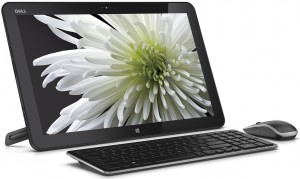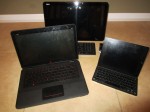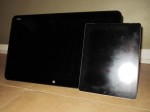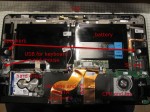 Hey, just so you know ... this post is now about 10 years and 10 months old. Please keep that in mind as it very well may contain broken links and/or outdated information.
Hey, just so you know ... this post is now about 10 years and 10 months old. Please keep that in mind as it very well may contain broken links and/or outdated information. Our family laptop (an hp Envy 14 Beats Edition) has taken a beating (no pun intended!) over the past few years and recently (thanks to be carried around by the screen by my daughter) the LCD has gone wonky, requiring a bunch of futzing to get the display to work properly.
Our family laptop (an hp Envy 14 Beats Edition) has taken a beating (no pun intended!) over the past few years and recently (thanks to be carried around by the screen by my daughter) the LCD has gone wonky, requiring a bunch of futzing to get the display to work properly.
The recent tax-free weekend here in Florida (for back-to-school) was different than in years’ past in that the first $750 of a computer purchase would be tax free. This seemed like a good time to get a new family PC before the new school year started so I did some quick research and ended up with the Dell XPS 18.
The XPS 18 is an “portable” all-in-one desktop PC running Windows 8.1. The tablet is just under an inch thick, weighs just over 5lbs, and houses the 18.4″ touchscreen, Intel Core i5 processor, 8gb RAM, Intel HD graphics, a 1TB hard drive, 2 USB 3.0 ports, audio jack, SD card slot, wireless AC, Bluetooth 4.0, front-facing HD camera, stereo speakers, and built-in feet. Also included are the wireless keyboard, mouse, and power supply. My research indicated that all Core i5 and higher models included the optional charging stand ($99) but mine didn’t (possibly because I bought it retail instead of direct from Dell … I’ve contacted Dell support about this and am still waiting for a response). Also missing from my retail version was the 32gb mSATA SSD (used for caching the 1TB traditional drive, but more on why that wasn’t a big deal later).
Since we already have been using Windows 8.1 on the old laptop, setting up the XPS was a breeze. We just each logged in with our Windows Live credentials and our settings synced across. Then it was just a matter of copying our files from the laptop to the XPS. This took a little while over wireless, so I’ve ordered a USB 3.0-to-ethernet adapter for the future when I need to do large file transfers. There was no crapware or bloatware installed on the XPS, so I didn’t have to spend a lot of time uninstalling junk I didn’t want.
The beauty of the XPS (other than its looks) is that you get a decently powerful 18″ desktop PC, but can easily transport the tablet portion since it has a built-in battery. Theoretically we could slip it into a backpack and take it with us on family vacations (like our recent Houston road trip). The flip-out feet let it stand up, or lay down at an angle, although we found that the roughly 100-degree angle didn’t work too well with Skype and shorter people since the camera was pointing too high (this is probably another reason why Dell sells that adjustable stand). It has rubberized edges for gripping when you’re carrying it, and small rubber feet on the back for when it’s laying down on a table.
Opening the XPS is very simple: just 10 screws and the black plastic back lifts off, exposing the hard drive, mSATA port, and memory slot. 4gb of RAM is built into the motherboard, so the user-accessible slot has another 4gb chip in it (which could be replaced with an 8gb one for a total of 12gb if I wanted to). Another nice touch is that the unified USB receiver for the keyboard and mouse is internal, so it doesn’t take up one of the external USB ports (this also means you can replace it with a different dongle from a new wireless keyboard/mouse set if you wanted to as well). As I mentioned earlier, the mSATA port in my retail unit was empty so I ended up getting a 256gb mSATA SSD and cloning the 1TB hard drive to it so I could run Windows off the faster drive, increase battery life a little, and get rid of the spinning drive. Granted this means we don’t have 1TB of storage in the family PC anymore, but since we each have 1TB of OneDrive storage with our Office 365 subscription we don’t really need that much locally (and I can always put it back or put in a 2.5″ SATA SSD later if necessary). And although no one else in the family will notice, this also shaved about 2 ounces off the weight of the tablet. I did have some scary moments after cloning the drive where Windows 8.1 wouldn’t boot at all, but was able to fix it following this article.
Finally, normally I use SpiderOak to backup each PC on the home network but I’ve been doing a little re-organization of my backups since getting my Synology NAS a few months ago. Rather than having to mess with SpiderOak on each PC, I’m using the strategy described here to backup each machine to the NAS with BitTorrent Sync and then only run SpiderOak on the server to send the files to the cloud. It may seem like more moving parts, but the management is a lot easier for me and now I only have to deal with SpiderOak on a single machine.
Overall, I’m very satisfied with our new Dell XPS 18. Time will tell if my daughter misses having a laptop (although she still has her Surface RT to travel with if we don’t feel like lugging the XPS around) or if we find the tablet too limiting in terms of ports of features, but so far it’s a hit for the family.
- XPS, envy 14, iPad
- XPS vs iPad
- XPS internals



Back in November the XPS battery stopped holding a charge. The “plugged in, not charging” message in Windows seemed to be a common problem with the Dell XPS line and some people had luck replacing the battery so I ordered one on Amazon. After some minor surgery, the new battery seemingly resolved the issue. But then in February, the problem surfaced again! Another suggested solution was using the charging stand so I bought one of those off of eBay but that didn’t help either. Now the machine wouldn’t even recognize it was plugged in, and without a charging battery, it just wouldn’t run.
So I’ve replaced it with the hp Pavilion 24-r014 all-in-one PC.